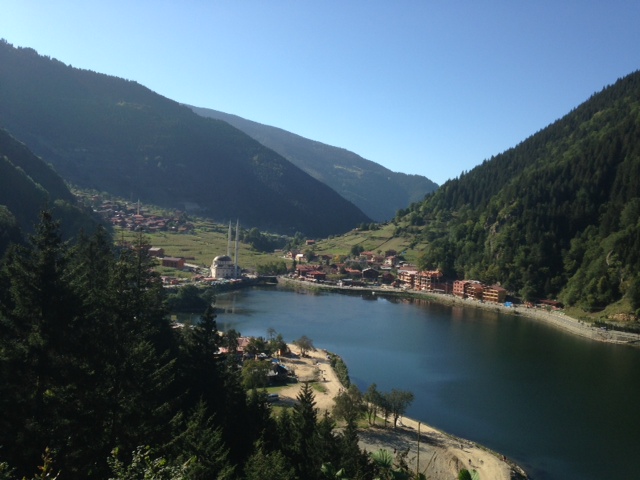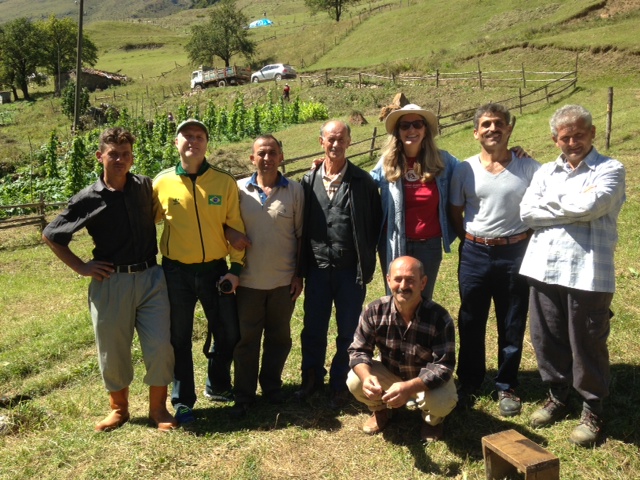"Bu lezzetli!"
Learn this phrase if you're heading to the Black Sea Region of Turkey. It means "this is delicious" and, I guarantee, you will use it more than "Hello!" "My name is_____" and "Where is the bathroom?"
Cuisine, throughout Turkey, is a point of deep pride and, particularly in the Black Sea region where it's impossible to be in the general vicinity of another human being without being handed a fig or a hazelnut or a bowl of fresh yogurt made that morning from the milk of their own cow.
Hospitality is so over-the-top (commerce, it seems, is beside the point) that any notions you ever had that foreigners are to be feared or that life sucks or that the world is going to hell in a hand basket will be dashed against the inhospitable shores of the Black Sea, a region in Turkey that looks more like the Colorado Rockies than Lawrence of Arabia.

It's definitely not the place to give up caffeine, because every shopkeeper, every museum guide, every little old grandma wearing a colorful hijab (head scarf) will offer you a glass of tea (cay) along with a little teaspoon and a bowl of sugar.
And how can you refuse? The tea is grown right there on lush, green mountainsides in small family plantations. Ömer Faruk Öğretmen, the never-married tour guide who whisked us around to one little yayla (village) after another, says he averages between 30 and 40 glasses of tea per day. Just because people offer.
By the time you've had your second cup of the always-ready tea, you'll be introduced to the whole family -- second cousins and all -- serenaded with folk music and invited back for dinner.
Over and over again, our little band of three Americans was invited into local's homes not only for tea, but for full-blown meals. Even on deserted mountain roads, where we had to pause for chainsaw-bearing men to remove fallen trees that would otherwise have deterred our journey, young boys wearing rubber boots and Sponge Bob t-shirts appeared out of nowhere to offer pears they had just picked.
The nomadic herders of the Black Sea Region, ethnic Georgians, Armenians and Pontic Greeks, summer on ancestral lands throughout these isolated valleys. They earn their living off the land, herding cows, making cheese and harvesting tea, citrus and honey.
Although the Hamsis, as the locals are nicknamed (after the anchovy caught in this region) are often the good-natured butt of jokes in Turkey, their inexhaustible cheer, smiles and friendliness are wildly infectious, enough to sway the most cynical of tourists. Their local dance, the horon, an upper body shimmy modeled again after swimming anchovies, is said to have inspired Irish jigs and whether or not it's true, I can attest that Michael Flatley has nothing on their exuberance.
One late morning, after a "one-hour drive" to the Santa Ruins, a crumbling 17th century village high in the Kackar Mountains, turned into three and a half hours, several farmers who were busy harvesting the last of their summer squash and ruing the wolves that had made quick work of one of their cows the night before, dropped everything to make us, their uninvited guests, feel welcome.
Ahmet Cukur showed us around the one-room shelter where he, his wife and three kids slept at night. He proudly showed us his gun, offering to shoot wild boar that he would happily send us if we wanted to start a business. He was Muslim and, of course, couldn't partake.

His wife -- on the spot -- whipped up an incredible lunch of muglama, a cheese soufflé-like dish made from corn flour, cheese and butter and rumored to deliver superhuman powers. She served it with just-baked-in-the-stone oven bread, grapes and a fresh salad of tomatoes and cucumbers that the kids picked that morning before starting a soccer game on a makeshift field that cascaded down the mountain. We dined outside on rocks and small wooden benches that Ahmet pulled from his home as the entire community stood around, offering jokes, handshakes and sincere invitations to come for the whole summer next year.

Another evening, our driver who had been married just 14 days earlier, invited us into his home (completely unbidden) for a feast prepared by his gorgeous new bride. In Kavron, a little village above the tree line that looked more like Nepal or Tibet than Anatolia, we were graciously invited into the home of a 100-year-old woman, still spry, quick-witted and, of course, as welcoming as any concierge.
So, yes, the Black Sea Region has stunning Alp-like vistas, castles, ancient monasteries carved into cliffs and charming seaside villages with ancient Ottoman homes, but it is its people -- it's open-hearted, joyful people -- that are the true treasure and the reason I may just take Ahmet up on his offer to return next summer.